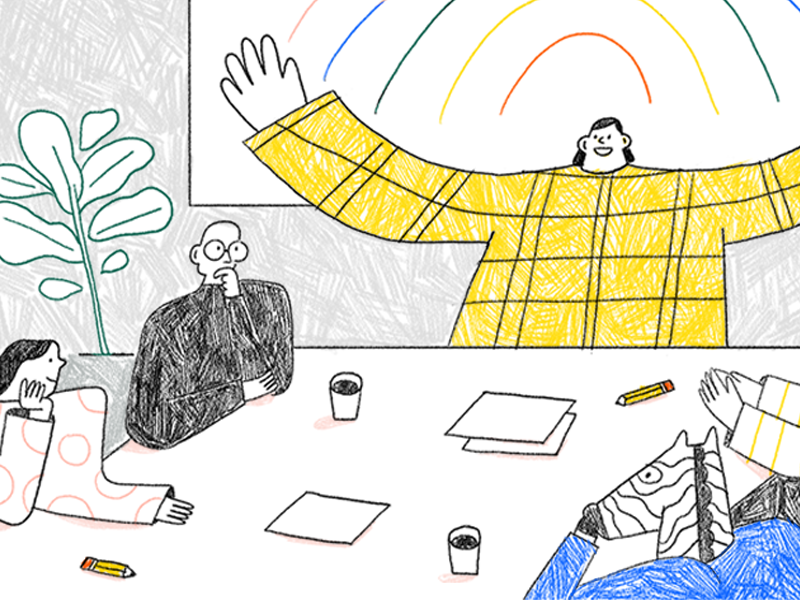This article was written by our friends at Creative Market, the world’s marketplace for ready-to-use design assets ■
You’ve spent days working on a design concept. Tedious back and forth, dozens of sketches, countless cups of coffee. Perhaps a couple of all-nighters. Now you’ve officially refined an idea and are ready to present it. Strong work deserves an equally compelling introduction, and the way you expose an idea to a client for the first time has an undeniable impact on how it’s perceived and whether it’s ultimately accepted.
Throughout this article, we’ll go over five tips to elevate your design presentations, highlighting the full breadth of the creative process you’ve worked so hard on.
1. Describe the challenge
What was the initial objective? What about this brand was in need of a design solution? Stating these goals, even if known to the client, frames your work in a problem-solving context. Everything they’ll see next is now perceived as a response to a clear business challenge. Aside from helping you present ideas to the current client, this process also leaves you with case study content you can share to engage future clients.

Forefathers Group summarizes the intention behind their branding work for 13 Stripes Brewery
2. Document the process
If you were a journalist sitting behind your desk, what would be noteworthy? What were some of the decisions you made that were second nature to you but impacted the end result nonetheless? I’ve found myself having to write these down as I work to avoid missing them. Stop, think about how you’re thinking, and document it. Here are some ideas about the process you might want to share:
- Competitors you audited
- Customer insights you considered. Share direct quotes whenever possible
- Moodboards you put together, no matter how rough
- Sketches you went through, even if low fidelity
- Aesthetic or material culture references
We tend to assume our aesthetic references and insights are crystal clear. The truth is, you’d be surprised at how often the ideas that are obvious to you are novel to others. Shedding light on your behind-the-scenes builds anticipation for the visual solution you’ll share next.
Start seeing yourself as a visual storyteller and find the narrative in your work. Give voice to the quieter parts of your process; those that often go unmentioned.

Ready-to-tweak presentation templates such as this one by Studio Standard can accelerate your process and help organize thoughts to share with your clients at this stage
3. Engaging Visuals
Context is the name of the game. How can you best help your client visualize what this concept can do for their brand? Realistic scenarios tell the customer “what’s in it for them”, going beyond flat artwork and into the realm of market applications. Consider real estate renders and their role in closing home sales. A family may fall in love with a property because there was a specific scene that catered to their everyday needs — perhaps even triggered an aspiration of something that isn’t in their lives yet.
This is the level of creative possibility you want to instill in your design presentations: an exciting vision of what’s to come. Decide how high-fidelity these visuals can be based on the project stage you’re in and the overall scope. If this is an initial overview of several concepts, you want to be mindful of the amount of time you have to create mockups and the level of detail you present.
Static and animated mockup templates can save you time when designing compelling visuals. They allow you to place your artwork in realistic scenes by editing Photoshop Smart Objects.

A corporate branding mockup pack like this one above can speed up your workflow
Something as simple as a coffee cup can truly come to life with an animated mockup like this one by Alexandr Bognat.
4. Make it a memorable experience
Designer Louise Filli says she serves gelato when clients come in for an initial design review. She claims “it never fails to put everyone in an extremely good humor.” I bet! Even if you don’t get a chance to meet in person, think of your “gelato effect”. What is that unexpected little treat that will get attendees in the right mood? Even remotely, physical artifacts are not out of the question. Could you mail them in advance?
5. Be diligent about feedback
Sharing work with clients shouldn’t feel like a monologue—active listening goes a long way in persuading them about your concept. Whether you’re presenting your ideas in person or remotely, take notes throughout the conversation. This seemingly small act shows your audience that you care about their feedback. When and/or if there’s a refined version of the concept to submit, including insights from these notes is key to effective client-designer communication.
How do you present design work to clients?
Over time, we learn to identify and even anticipate it: the moment when a client is about to say they love what they’re seeing. What have you found to be effective when presenting design ideas? Anything you’ve done that has been particularly persuasive? ■
![]() About the author: Laura Busche is the author of the Lean Branding book. Her approach to branding is blended, combining insights from an undergraduate degree in business, master’s degree in design management, and Ph.D. in consumer psychology. Laura is a Brand Content Strategist at Creative Market.
About the author: Laura Busche is the author of the Lean Branding book. Her approach to branding is blended, combining insights from an undergraduate degree in business, master’s degree in design management, and Ph.D. in consumer psychology. Laura is a Brand Content Strategist at Creative Market.
RELATED READING
- 11 tips for presenting your UI/UX designs to non‑designers
- How to turn negative feedback into design gold
- 10 key questions to ask clients before you start designing
Find more Process stories on our blog Courtside. Have a suggestion? Contact stories@dribbble.com.









